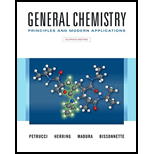
Interpretation:
The metal oxide that can be reduced to from metal on reaction with C atom from the given list needs to be determined using the coupled reactions method.
Concept introduction:
A non-spontaneous reaction can be changed to spontaneous reaction either by changing the reaction’s conditions like temperature or by combining the reaction with other reaction to get an overall spontaneous reaction. The spontaneity of the reaction can be determined with the help of sign of
At standard conditions, the
Want to see the full answer?
Check out a sample textbook solution
Chapter 13 Solutions
Mastering Chemistry With Pearson Etext -- Standalone Access Card -- For General Chemistry: Principles And Modern Applications (11th Edition)
- Actually, the carbon in CO2(g) is thermodynamically unstable with respect to the carbon in calcium carbonate(limestone). Verify this by determining the standardGibbs free energy change for the reaction of lime,CaO(s), with CO2(g) to make CaCO3(s).arrow_forwardThe equilibrium pressure of H2 over solid uranium and uranium hydride,UH3, at 500K is 1.04Torr. Calculate the standard Gibbs energy of formation of UH3(s) at 500K.arrow_forwardCalculate the Gibbs energy and equilibrium constant for the chemical reaction at a temperature of 298.15 K. Hg2Cl2(s) → → 2 Hg(l) +Cl2(g). Does the value of the equilibrium constant you calculated describe your understanding of the spontaneity of the reaction in the direction of the arrow?arrow_forward
- Certain bacteria in the soil obtain the necessary energy for growth by oxidizing nitrite to r nitrate: 2NO2- (aq) + O2(g) —> 2NO3-(aq) Given that the standard Gibbs energies of formation of NO2- and NO3- are -34.6 kJ mol-1 and -110.5 kJ mol-1, respectively, calculate the amount of Gibbs energy released when 1 mole of No2- is oxidized to 1 mole of NO3-.arrow_forward7.3(a) From information in the Data section, calculate the standard Gibbs energy and the equilibrium constant at Ty (a) 298 K and (b) 400 K for the reaction PbO(s) + CO(g) 5 Pb(s) + CO2(g). Assume that the reaction enthalpy is independent of temperature.arrow_forwardThe standard Gibbs energy of the reaction 2 NO2(g) → N2O4(g) is −4.73 kJ mol−1 at 298 K. What is the value of ΔrG when Q = (i) 0.10, (ii) 1.0, (iii) 10, (iv) 100? Estimate (by interpolation) the value of K from the values you calculate. What is the actual value of K?arrow_forward
- The standard Gibbs energy of the reaction N2(g) + 3 H2(g) → 2 NH3(g) is −32.9 kJ mol−1 at 298 K. What is the value of ΔrG when Q = (i) 0.010, (ii) 1.0, (iii) 10.0, (iv) 100 000, (v) 1 000 000? Estimate (by interpolation) the value of K from the values you calculate. What is the actual value of K?arrow_forwardFor the reaction N2 (g) + 3H2(g) --> 2 NH3 (g), (a) what is the reaction Gibbs free energy at equilibrium in J/mol? The equilibrium constant of the reaction N2 (g) + 3H2(g) --> 2 NH3 (g) at 81 oC is Keq = 478,789. (b) What is the standard reaction Gibbs energy of this reaction in J/mol?arrow_forwardCalculate the standard Gibbs energy of the reaction CO(g) + CH3CH2OH(l) → CH3CH2COOH(l) at 298 K, using the values of standard entropies and enthalpies of formation given in the Resource section. The data for CH3CH2COOH(l) are ΔfH⦵ = −510 kJ mol−1, S⦵m = 191 J K−1 mol−1 at 298 K.arrow_forward
- The standard reaction Gibbs energy of the decomposition of CaCO3 into CaO and CO2 at 1173 K is +0.178 kJ mol-. Calculate the equilibrium constant of the isomerization.arrow_forwardOne ecologically important equilibrium is that between carbonate and hydrogencarbonate (bicarbonate) ions in natural water. (a) The standard Gibbs energies of formation of CO32−(aq) and HCO3−(aq) are −527.81 kJ mol−1 and −586.77 kJ mol−1, respectively. What is the standard potential of the HCO3−/CO32−,H2 couple? (b) Calculate the standard potential of a cell in which the cell reaction is Na2CO3(aq) + H2O(l) → NaHCO3(aq) + NaOH(aq). (c) Write the Nernst equation for the cell, and (d) predict and calculate the change in cell potential when the pH is changed to 7.0 at 298 K.arrow_forwardThe standard Gibbs energy of formation of NH3(g) is −16.5 kJ mol−1 at 298 K. What is the corresponding reaction Gibbs energy when the partial pressures of the N2, H2, and NH3 (treated as perfect gases) are 3.0 bar, 1.0 bar, and 4.0 bar, respectively? What is the spontaneous direction of the reaction in this case?arrow_forward
 Chemistry: The Molecular ScienceChemistryISBN:9781285199047Author:John W. Moore, Conrad L. StanitskiPublisher:Cengage Learning
Chemistry: The Molecular ScienceChemistryISBN:9781285199047Author:John W. Moore, Conrad L. StanitskiPublisher:Cengage Learning Principles of Modern ChemistryChemistryISBN:9781305079113Author:David W. Oxtoby, H. Pat Gillis, Laurie J. ButlerPublisher:Cengage Learning
Principles of Modern ChemistryChemistryISBN:9781305079113Author:David W. Oxtoby, H. Pat Gillis, Laurie J. ButlerPublisher:Cengage Learning

